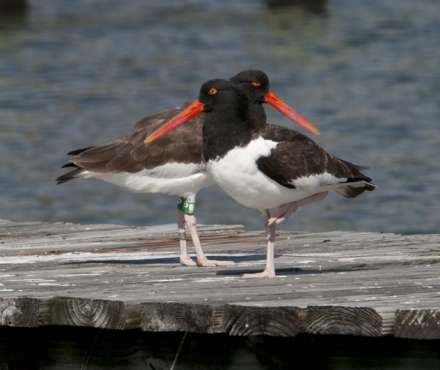Coordinating across eight agencies to count vulnerable shorebirds

How do you monitor a vulnerable shorebird species when its breeding areas are scattered across lands managed by a patchwork of state agencies, federal agencies, and non-profit conservation groups? American Oystercatcher (Haematopus palliates) nests are sparsely distributed, time-intensive to find, and often in remote locations, all adding to the challenge of estimating the size of their breeding population. However, a new study in The Condor: Ornithological Applications demonstrates that a new, simplified survey method, coordinated across 8 agencies, has tremendous potential to provide accurate population estimates and aid in the species' conservation. Rather than searching for and counting each individual nest, researchers recorded how many oystercatchers they observed within suitable nesting habitat and then modeled the size of the breeding population from this data.
Nathan Hostetter of North Carolina State University and his colleagues in the American Oystercatcher Working Group (amoywg.org) surveyed 93 plots across coastal North Carolina and the eastern shore of Virginia. Multiple agencies, including Audubon North Carolina, the Cape Hatteras National Seashore, North Carolina University, and Virginia Department of Game and Inland Fisheries, collaborated to survey all 93 plots using the same protocol in a single breeding season in 2013. They estimated that the population of oystercatchers within the survey area was 1,048 individuals, and comparisons with more exhaustive surveys in a subset of the study area show that this number is likely accurate.
"Our study developed as part of larger efforts to investigate Atlantic coast American Oystercatchers across their entire range," explains Hostetter. "Our ability to utilize data collected by multiple agencies that often independently monitor American Oystercatchers was exciting and shows great promise for future range-wide surveys. Standardizing field methods and protocols required a lot of pre-season brainstorming and effort from all agencies. The ability to integrate studies at the end of the season, however, was extremely rewarding and provided insights at spatial scales that no single agency could accomplish alone."
"This study will help advance oystercatcher conservation and management because it provides a robust monitoring framework that will facilitate collaboration across agencies and organizations," adds James Lyons, an oystercatcher expert with the U.S. Fish and Wildlife Service who was not part of the study. "The validation study with intensively monitored sites provides clear evidence that, with the appropriate analytic framework, extensive monitoring can provide reliable information about population status and inform management decisions."
More information: Repeated count surveys help standardize multi-agency estimates of American Oystercatcher (Haematopus palliates) abundance is available at www.aoucospubs.org/doi/full/10 … 1650/CONDOR-14-185.1
Provided by Central Ornithology Publication Office




















